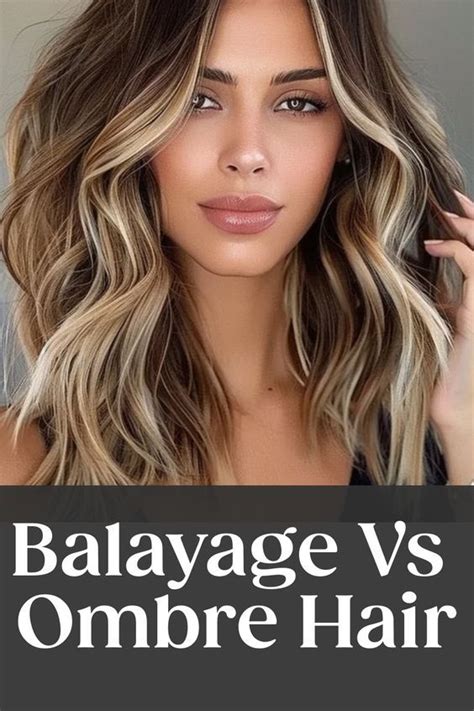Introduction

Balayage and ombre are two popular hair coloring techniques that create distinct and eye-catching looks. While both methods involve adding lighter tones to dark hair, they differ significantly in their application and the resulting effect. This article will delve into the details of each technique, exploring their similarities, differences, pros, cons, and common mistakes to avoid.
Balayage
Balayage (pronounced “ba-lee-azh”) is a freehand hair painting technique that creates subtle, sun-kissed highlights. The word “balayage” is French for “to sweep,” which accurately describes the gentle, sweeping motion used to apply the lightener.
Application:
- Colorist isolates sections of hair and applies lightener to the mid-lengths and ends.
- The lightener is swept or painted onto the hair in an irregular pattern, leaving some darker strands untouched.
- The result is a seamless blend of dark and light tones, resembling natural highlights.
Effect:
- Creates soft, diffused highlights that blend seamlessly with natural hair color.
- Adds a subtle sun-kissed effect that can enhance facial features.
- Suitable for all hair types and tones, but particularly effective on darker hair.
Pros:
- Low-maintenance and requires less upkeep than other techniques.
- Gradual fading over time, resulting in a natural-looking grow-out.
- Can be customized to create a wide range of looks, from subtle to dramatic.
Cons:
- Can be more time-consuming than other techniques.
- Requires a skilled colorist to achieve the desired effect.
- May not be suitable for very short or fine hair.
Ombre
Ombre is a hair coloring technique that creates a graduated blend of dark and light tones, with the darkest shade at the roots and the lightest shade at the tips. The term “ombre” is French for “shading” or “shadow,” which accurately describes the gradual transition of color.
Application:
- Colorist selects two or more shades of hair color and applies them to the hair in horizontal sections.
- The lighter shade is applied to the ends of the hair, while the darker shade is applied to the roots.
- The colors are blended together to create a smooth, gradient effect.
Effect:
- Creates a striking and dramatic contrast between dark and light tones.
- Can be customized to create various looks, from subtle to vibrant.
- Suitable for all hair types and tones, but particularly effective on long hair.
Pros:
- Adds depth and dimension to the hair.
- Allows for a wider range of color choices than balayage.
- Can be easily maintained with regular root touch-ups.
Cons:
- Requires more upkeep than balayage.
- May not be suitable for short hair or hair that is damaged or prone to breakage.
- Can be more expensive than balayage.
Similarities and Differences
Similarities:
- Both balayage and ombre involve adding lighter tones to darker hair.
- Both techniques can create a range of looks, from subtle to dramatic.
- Both methods can be customized to suit individual preferences and hair types.
Differences:
- Application: Balayage is applied with a freehand painting technique, while ombre is applied in horizontal sections.
- Effect: Balayage creates soft, diffused highlights, while ombre creates a gradual blend of colors.
- Suitability: Balayage is more suitable for dark hair, while ombre can be applied to all hair types and tones.
Which Technique Is Right for You?
The best hair coloring technique for you depends on your individual hair type, color, and desired look.
- If you prefer a low-maintenance and natural-looking highlight, balayage is a great option.
- If you want a more dramatic and striking color contrast, ombre is an excellent choice.
- If you have dark hair and want to add subtle highlights, balayage is ideal.
- If you have long hair and want a gradual blend of colors, ombre is the better option.
Pros and Cons Table
| Technique | Pros | Cons |
|---|---|---|
| Balayage | Low-maintenance | Time-consuming |
| Seamless blend | Requires skilled colorist | |
| Custom looks | Not suitable for all hair types | |
| Ombre | Dramatic contrast | Requires regular upkeep |
| Wide color range | Expensive | |
| Depth and dimension | Not suitable for short or damaged hair |
Common Mistakes to Avoid
- Over-lightening: Avoid using too much lightener or leaving it on for too long, as this can damage the hair.
- Unnatural placement: Ensure the highlights or ombre blend seamlessly with your natural hair color.
- Unbalanced color: Choose shades that complement your skin tone and overall style.
- Inconsistent application: For both techniques, it’s important to apply the color evenly and with precision.
- Over-processing: Avoid over-treating the hair to prevent breakage or damage.
Conclusion
Balayage and ombre are both versatile hair coloring techniques that can create a wide range of looks. By understanding the differences and similarities between the two methods, you can make an informed decision about the best option for your individual needs. Whether you prefer subtle highlights or a bold color contrast, there’s a hair coloring technique that’s perfect for you.
